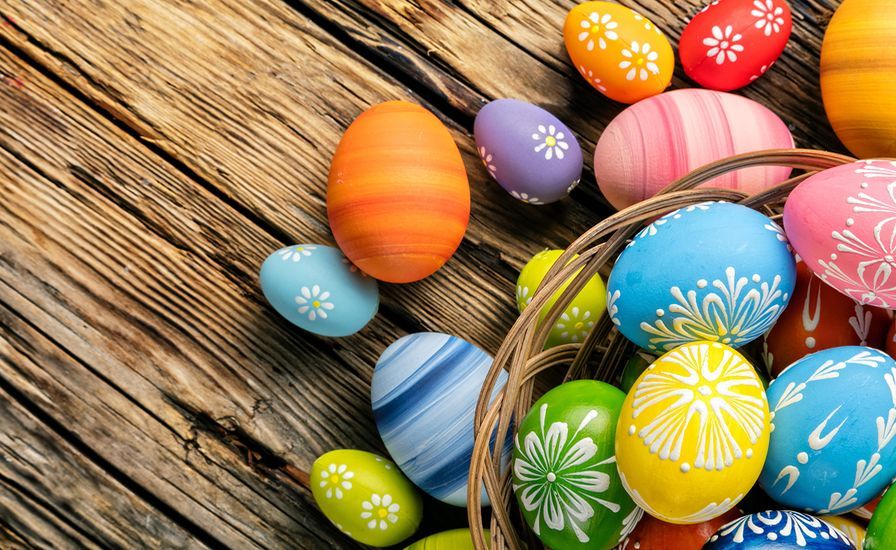With the first rays of spring and the melting of snow, the first flowers awaken. In addition to snowdrops, other early flowering plants are also harbingers of spring.
Instructions
- The first spring flower is Chionodoxa luciliae. Due to its early flowering, this plant also has another name - Glory of Snows. A small (up to 15 cm) bulbous plant breaks through the melting snow and blooms for two weeks. On a thin stem there are 10-15 flowers with a diameter of up to 3 cm, externally resembling wide bells. Bright blue, blue, lilac flowers and linear emerald leaves adorn the mountain slopes and alpine meadows at an altitude of about 2 km.
- The most famous (and therefore very rare today) primrose is the Common Snowdrop (Galanthus nivalis). The snowdrop is recognizable by its linear leaves, which it produces first, and its white drooping bells. This delicate frost-resistant plant is listed in the Red Book. Therefore, you should think carefully before picking these primroses.
- The harbinger of spring in our latitudes is Vesennik or Eranthis hyemalis. It is a single bush up to 30 cm high, on which there are many yellow cup-shaped flowers of medium size. Vesennik's leaves are thin and heavily dissected. The plant has a rich honey aroma.
- Almost simultaneously with Vesennik, the purple, white, yellow and bluish flowers of the Iris reticulata bloom. The plant has thin linear leaves, produces a pleasant aroma and blooms from February to April. The reticulated iris rises above the ground by only 8-15 cm, half of which is the length of the flowers.
- In early spring, Caltha blooms in flower beds, parks and meadows. At the beginning of April you can see it everywhere yellow flowers with five round petals. The leaves of Marigold are dark green, wide, heart-shaped.
- Another bulbous primrose is the spring whiteflower (Leucojum vernum). The edges of mountain beech forests are decorated with a plant up to 20 cm in height with white drooping flowers in the form of wide bells, which can be single or paired. You can recognize the spring whiteflower by the characteristic green or yellow color of the tips of the petals. The perianth sparkles with crystal whiteness against the background of green, broadly lanceolate leaves.
- The trees also have their own primroses. They are wind pollinated and therefore bloom before releasing their leaves. This happens to ensure that nothing interferes with pollination. Trees such as alder and willow are the first to bloom. Their inflorescences, rich in pollen, are a salvation for the first insects in search of food.
KakProsto.ru
Blooms in February-March. Spring in the Macin Mountains is a favorable season for lion's foot, Romanian peony, Dobrogozh's call, rock tusk, gelding. This species is widespread in southern and western Europe, extending north to southern England and southwestern Hungary, the Caucasus, Asia Minor, Iran, and North Africa. In Romania we can meet in the counties of Caras Severin, Mehedinti, Constanta and Tulcea. It is a perennial herbaceous plant with whole tubers, spherical and fibrous roots.
The flowers are pale purple to dark purple and bloom from top to bottom. All types of orchids in our country are protected by law because they are rare and vulnerable taxa. Hiking and biking can be enjoyed in the Makina Mountains. The bike trails are of moderate difficulty and connect areas around the park on existing roads.
Why do plants bloom?
The flowering period is the process of sexual reproduction of plants, which begins with the formation of flower primordia in the buds, followed by their appearance, pollination and flowering, resulting in the appearance of seeds and fruits, allowing the plants to continue their genus. At the same time, flowering time for different plants occurs at different periods of their life cycle. For example, the first flowering of annual plants begins early, after the sprout sprouts, becomes established in the soil and produces a pair of leaves. Other plants (this primarily applies to trees), before the first flowering begins, develop a root system and accumulate nutrients so that flowers and seeds develop normally.
Nineteen local communities live near the park, with almost 000 residents traditional activities Dobruja and the minorities living in this area of the Danube. On the ridges and at the foot of the mountains there are ancient fortresses and monasteries, of interest for ecotourism and religious tourism, in addition to the landscape.
Greece, where the Tourist Information Center is located, is 148 km from Constanta. Although short is quite demanding and it is preferable to park in spring or autumn when it is not very warm. Before the peak you will come across two springs to quench your thirst, but be careful, their flow is low during hot days summer days. Camping and fires are only permitted in designated areas that are properly marked. You should also be aware that it is strictly prohibited to collect or clear any woody vegetation to start a fire.
Annual and biennial plants bloom once in their lives and die, having spent all their strength and energy on this process. True, among such flowers there are also perennial plants, for example, the first flowering of Puya Raymondia, growing in the Andes, begins at the age of one hundred and fifty years.
As for perennial herbaceous and woody plants, their first flowering begins no earlier than they reach a certain age: in herbs, the beginning of flowering ranges from two to five years, while the flowering of trees begins in the twentieth, and in some species even in the thirtieth year life.
Tourists are required to collect the waste they create while visiting the park. Material by Liliana Fustanela. Crocus blooms in spring, autumn and even winter. Crocuses are one of the first flowers to bloom in spring and are also one of the least demanding. Naturally, this cluster-emitting clay plant is growing in the Mediterranean and Black Sea region, Central Asia, Southern Europe. The most seductive real hooked, with dried flower pots is saffron, one of the most valuable and expensive spices.
Krok's name comes from Greek mythology: the god Ermi, who accidentally killed his friend Krok, turned him into a flower. The most common Dutch spring cake. In spring, flowers bloom in March-April only after the snow melts. The autumn vine blooms in the fall, and this group also has its own arches.
Unlike annual and biennial plants, flowering of perennial plants occurs many times. Some of them are characterized by periodicity (most fruit trees bloom once every two years, and oak - once every five to seven years), while others have a continuous flowering period (especially this refers to tropical plants, such as the coconut palm).
Often the autumn fold is confused with the late one - a completely different plant. Late flowers are larger and the leaves are wide, except for the fold 3 pockets, and late, despite the similarities, you should not make saffron from late sauce, this plant is very poisonous. Autumn creeps in the spring, producing leaves that fall during the summer, and in the fall the plant will produce flowers only on a long stem. Crochet rings are blue, blue, purple, yellow, white with lines, glitter or white in the ring inside. The leaves are long and thin, with ribbons, springy curls that release them either with flowers or after flowering.
How plants bloom
Inside each flower there is a pistil (the part of the flower where, after fertilization, seeds are formed that begin to grow and turn into fruits) or a stamen (it contains the pollen necessary for fertilization, it is also called the male reproductive organ), or both.
Seeds in the pistil begin to form no earlier than pollen from the stamens reaches the stigma of the pistil. But for this, pollination is necessary. If it does not happen on time (and it happens during flowering), the pistil will dry out and reproduction will not occur.
Wrinkles cannot grow in one place for up to 5 years, often growing in pots like bouquets. Crops are spread by bulbs. Crocuses are soil-conscious, but do not like heavy or polluting soils. For spring traction, it is suitable for areas where the snow melts first. They even crawl through the lawn, return to the beginning of the grass season and wait again next spring. That's why sunlight is chosen for the frame, although it can also be planted in shrubs whose foliage covers the covered leaves in summer.
If the soil is difficult to plant, it can be mixed with sand, compost and wood ash added. The cracks are more similar to neutral and alkaline soils. Autumn plots are planted in August. In heavier primers they are planted at two bulbs, and in dinners - 3 bulb heights. The distance between the bulbs is 10 centimeters. You can plant with a week break, then you can expect flowering within different times.
Pollen
It is interesting that if a flower has both a pistil and a stamen, it is rarely pollinated by its own pollen: plants almost never allow this. The reason is simple: in order to form a fruit from which strong and strong plants will sprout, pollen must be obtained from a neighboring flower (this process is called cross-pollination).
Spring drafts are planted in the first half of September. Crabs will bloom better and grow larger if they are harvested every few years. They don't grow longer, they shrink and smaller rings grow. It is necessary to replant the corrosion every 5 years. Spring bulbs are harvested in July-September, cultivated in autumn in June-August, dried and stored in a sunny place, they can be exposed to the sun.
In the fall, they are fertilized with complex fertilizers, which have more potassium and phosphorus, and in the spring, nitrogen fertilizers quickly dissolve. Crocus can bloom in pottery. Cracks can be enjoyed in winter. Bulbs of the same breed and similar size are selected for flowering in a pot. It is best to use spring nut colonies.
Therefore, when the flowering time begins, in order to avoid the possibility of pollination by its own pollen, the stamens and pistils within the same flower mature at different times of flowering. For example, the pistil ripens first, and after it is pollinated by pollen from a neighboring flower, the anthers of the stamen open. It is because of this that we can observe the flowering of perennial plants for about two to three weeks a year.
For early flowering, the bulbs are dried for 4-6 days at room temperature. Then they are transferred to a room where the temperature is 4-9 degrees, best placed in a refrigerator with a constant constant temperature. Wrap the paper for about a month. The optimal cooling time is the end of August, beginning of September. It is desirable that the cooling time and attenuation of early flowering be at least 3 months.
The nest is planted in neutral, unstable and fertile soil. The bulbs are planted close to the surface or even leave some free tops. The bulbs should not touch each other or the wall of the plate. This can be planted in layered soil: in the lower part of the bulb after being in the lower, fertile substrate and the same bulb is showered with sand. This reduces the chance of rotting and the lamp has access to nutrients.
Wind-pollinated flowers
There are plants in which the stamens and pistils are located not only in different flowers, but also “at home”: the flowers of some plants have only pistils, while others have stamens. Such plants are called dioecious and include willow, poplar, date palm, hops, hemp, and nettle.
This means that in order to pollinate the pistil during flowering, pollen must fly from one flower to another, and the desired flower may well be several kilometers away. Dioecious plants have adapted to this in a rather original way: some use the wind, others use insects.
After planting, the boxes are opened and placed in the refrigerator. When the height reaches 5 centimeters, it becomes noticeably full, exposed to light and heat. During the first few days they are stored at temperatures up to 15 degrees, in the light. To prolong the color, you can reset even in sub-zero temperatures at night. Thus, flowering spreads over 3 weeks.
Watering both pink and flowering ones should be done with caution only when the top layer of soil is toasted. Early flowering for New Year and January regime. Planting - end of September. . Early flowering in February - March. Crochet gold or gold. Plants up to 8 centimeters high. Flowers appear in early spring different colors and shades, mostly yellow and blue with clearly visible piers. They are distinguished not only by their many blooms, but also by their scented flowers.
Wind-pollinated plants are interesting because they never have bright and fragrant flowers, which, firstly, would interfere with the movement of pollen, and secondly, would attract insects that could easily break the thin stamen filaments with anthers. Therefore, instead of petals, such plants usually have either inconspicuous scales that protect them from the negative influences of the environment, or no petals at all.
They are larger than the early folds that bloom after snowflakes, before tulips. It forms a separate group, which is also known as a "curl". Dutch hybrid pleats are created from spring crochet and crossing different varieties. The rings range from white to dark purple.
Used for early flowering. Queen of Blue is the purple ring, Mammoth Yellow is the largest of the yellow golds crochet hooks. Peter Pan - rings up to 3 centimeters, white cream, with very delicate lilacs, bloom in April. Suitable for group planting and early flowering.
Interestingly, plants even take into account the inconstancy of air currents, so those that are pollinated by the wind usually grow close to each other: birch and pine trees form forests, corn, rye and other cereal crops occupy huge fields. All flowers that are pollinated by air masses create a lot of pollen; for example, just one adult corn sprout contains about 50 million pistils.
Pickwick - white rings with purple veins, the breed is suitable for early flowering. Memory - shiny purple rings. Sky blue - four centimeter rings, lilac with blue tones, blooms in April. Suitable for grouping and early flowering.
Striped Beauty - Purple white striped rings used for early flowering. It blooms from the end of April, suitable for planting in groups and rockeries. Pale ocher cream with small cream rings. Fragrant knitted with purple rings.
Smooth whorls are one of the last flowering species. Long flowering - also from late flowering. Gorgeous crochet earlier in other fall folds. Pink rings with purple stripes, blue and white. The actual fold or folds of the saffron have already been mentioned.
Therefore, no matter which direction the wind blows during flowering, pollen will still find suitable flowers. Moreover, plants do not wait until the pollen is directly in the flower, but catch them with the long and fluffy stigmas of the pistils: when the pollen ends up between the hairs, it gets entangled in them.
There is one more circumstance that facilitates the work of air flows: plants that use wind for pollination almost always bloom in early spring, before the leaves appear, which, by retaining pollen, could interfere with the process.
Spring is back in nature and you can enjoy it again. There are many medicinal plants that can be collected in the spring and then revive a weakened body after a winter or help yourself with various diseases. Below are some examples of plant materials that can be harvested in the spring. The peak season for medicinal plants is summer, but spring certainly has something to offer.
Great nettle is a perennial herb. The stem is quadrangular, straight. The entire plant is overgrown with small eyelashes. The rings are located in the leaves of the leaves, small and blurry. Great nettle blooms from July to October. This plant reproduces in two ways - rhizomes and seeds. Great nettles grow in fertile soils rich in rot, nitrogen and other plant-beneficial materials. This plant grows extremely abundantly near estates, shelves, and gardens.
Insects and pollination
It should be noted that this method of pollination is still not suitable for many plants, so they prefer to deliver their pollen to other flowers with the help of winged insects (bees, bumblebees, butterflies), luring them with honey, bright color and incredibly attractive aroma.
It is interesting that plants are quite picky when choosing the insect that is suitable for them: some prefer bees, others prefer bumblebees, and others prefer butterflies. Therefore, depending on preferences, they not only create the shape of flowers, inside which only a certain type of insect can be found, but also open their petals while this insect is awake (for example, all night flowers are white in color, since only this color is visible in darkness).
Great nettle is called one of the most important and useful herbs. Great nettle has been known in folk medicine for a very long time. It should be emphasized that this plant is used not only as an herb, but also for food - soups, salad, juice, green smoothies, etc. The only collected nettle leaves are rich in vitamins and minerals, and a variety of beneficial organic compounds. Nettle is primarily known as a plant that improves the general condition of the body - its tea, infusions, extracts or juice significantly improves overall well-being, helps the body quickly recover after a long winter, can help strengthen blood, hair, improve skin condition, and is suitable for seriously ill patients.
Plants that are characterized by early spring flowering, due to which pollination occurs with the help of bees, are white, yellow or blue - bees see only these colors. Closer to summer, a lot of red flowers appear - this tone is attractive to butterflies, which appear much later than bees. It is worth noting that white attractive to absolutely all types of insects.
The most commonly used medicinal raw material for nettles is the leaves or upper part of the stem; the roots of the great nettle are collected less frequently. Roots can be dug in late fall or early spring. They are thoroughly washed and then dried in special dryers. Made from root infusions, extracts. Recent studies have shown that honey extracts are especially important for men - they may protect against or improve prostate hyperplasia.
If you collect stems, it is best to collect them in the spring while the stems are young or in the summer before flowering. The collected stems should be thoroughly washed, then poured with boiling water and crushed. Prepared nettles are very suitable for cooking and complement valuable substances. The most useful are the youngest nettle leaves, collected in the spring. Nettle extract is very popular in cosmetics, in particular, for strengthening hair and scalp, reducing flaking, and shampoos are often enriched with herbs.
As for the honey that insects hunt for, it is hidden so deep in the flower that a bee, in order to get to it during flowering, needs to get between the pistils and stamens, smearing itself in pollen. After this, flying to another plant, making its way for the next portion of honey, it leaves some of the pollen in the flower.
The time when plants bloom
The timing of flowering primarily depends on the type of plant, the amount of pollen and flowers, climatic conditions and soil quality. For example, poor or too abundant nutrition slows down flowering and reduces the quality of flowers.
Flowering time for fruit trees in temperate latitudes of the northern hemisphere usually begins in mid-April and the flowering season lasts until mid-May. If, due to climatic conditions, plant flowering is observed in late summer or early autumn, this does not lead to anything good.
The secondary appearance of flowers on trees will deprive the gardener of a harvest next year, since flowers will not appear in this place after winter: the plant will spend additional nutrients on the flowering of trees, the formation of seeds or seeds, which is why it will become less winter-hardy and will endure the winter more difficult. Since this phenomenon cannot currently be prevented, in order to preserve nutrients in the tree, gardeners are advised to pick flowers and buds from it.
You can observe flowering plants throughout the warm season. To this end, many gardeners, when planning the landscape of their suburban area, take into account the flowering season and strive to ensure that the gardens continue to bloom as long as possible. To do this, they use specially compiled flowering calendars for tuberous and bulbous plants, which indicate the period and time of flowering of a particular species.
AwesomeWorld.com
Help!!! What is the significance of early flowering for a dandelion?
Elena
Why primroses bloom so early is not very clear. Perhaps to avoid competition for pollinators or to be the first to “develop” some other resources. But most likely, the answer lies in the history of these plants. There is an assumption that many of them appeared in the harsh climate of the Alpine mountain belt or in similar conditions that arose more than once during glaciations. To have time to produce seeds within short summer, plants in these conditions, like our primroses, begin to develop while still under the snow. Closely related species, for example, goose onion, scilla, corydalis, which are among the first to bloom in our country, still grow in the mountains.
Ivannych
Dandelion (Taraxacum officinale Weber). Widely distributed in Europe, Asia and North America. In many areas it blooms so profusely that in some years the fields and meadows present an almost continuous golden-yellow carpet. Due to its appearance in early spring, before fruit trees begin to bloom, dandelion is of great importance in beekeeping. In some years it provides a lot of nectar and a lot of pollen, when the bees need abundant food to raise brood.
Dandelion can significantly strengthen families, thereby increasing the main bribe later. In some areas, dandelion honey is sometimes sold on the market. In many areas, it commands a higher price than honey from fruit tree flowers. Although dandelion honey does not have a subtle taste, it is still used in baking. On many farms in Ontario and Quebec, Canada, more honey is harvested from dandelions in early spring than from any other plant. It appears to be spreading rapidly in Canada and the United States and is playing an increasingly important role as a honey plant.
Bees visit the dandelion: in May for two weeks, and if the weather is warm, even longer. The honey is bright yellow to dark amber in color (slightly darker than goldenrod). Honeycombs built during the honey harvest period from dandelions have a very beautiful bright yellow hue; even old honeycombs become yellowish. Freshly harvested honey is characterized by a strong aroma and taste of the plant. Ripe honey acquires a pleasant taste, although people accustomed to more tender honey, consider it too harsh.
Dandelion is not only beautiful, but also useful. Trying to destroy it, if it were possible, would be a big mistake. There can be no doubt about the beauty of its flowers, which are a model of symmetry. It is not harmful in hayfields, and when grazing cows it increases the amount of milk and improves its quality.
How do pine, spruce, cedar and other conifers bloom?
http://www.youtube.com/watch?v=ZfRfms3BSbQCedar has cones that look like a flower - 2 years ago
navik
Conifers, in our understanding, do not bloom, since they are not flowering plants, but gymnosperms. However, flowering is still not alien to them, only coniferous flowers do not look like flowers, but like cones or spikelets, which usually do not smell. Since conifers are wind-pollinated, they usually bloom before the leaves bloom on deciduous trees - otherwise the foliage could interfere with the transfer of pollen by the wind. This is how a pine tree blooms: 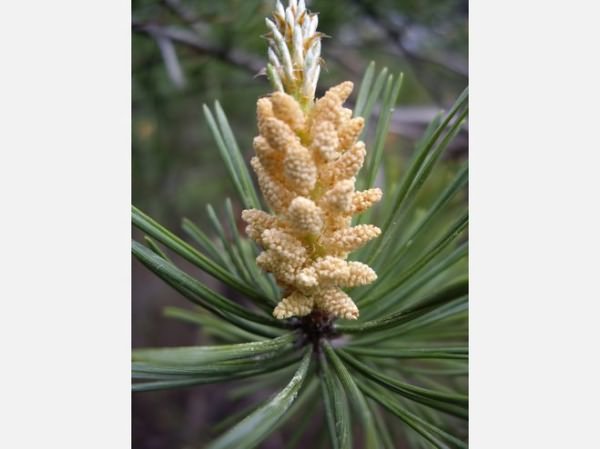
lorasvet
Coniferous trees, in the generally accepted understanding of flowering, do not have such an attractive appearance as, for example, the blossoming flowers of a cherry or apple tree. Coniferous flowers are similar in appearance to yellow spikelets (male inflorescences) or pinkish cones (female inflorescences). They usually bloom in May before young leaves appear on deciduous trees. Usually flowers do not smell of anything. Pollen from inflorescences is carried over long distances by the wind and “scares” ignorant people who see a threat to the health of others by observing yellow puddles and unusual dust on the roadsides.
Mirra-Mi
Flowers on coniferous trees very peculiar, not similar to other colors that we are used to seeing. But, like all flowers, they are beautiful. Amateur photographers, of course, also appreciate them and capture them in their photographs. thanks to them, we can also see how various coniferous trees bloom, which we may have never seen before.
Conifers include:
Cedar colors A:
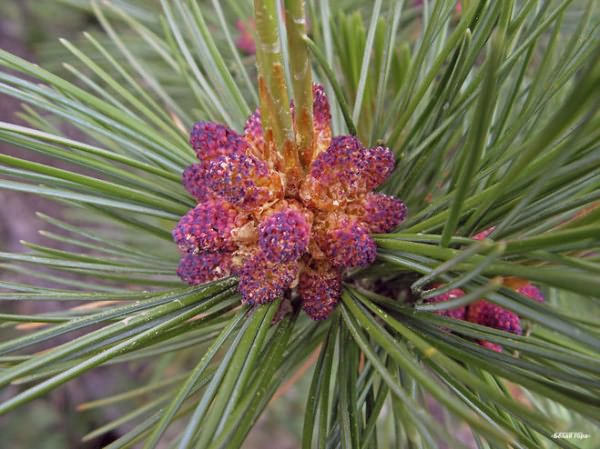
Veresk
Coniferous trees always bloom in early spring. Of course, they are not covered with beautiful flower buds; their cones perform this role. When I saw the amazing flowering of the Siberian larch, I didn’t believe it, I thought it was a photo montage, beauty!
Young oval-spherical cones (male cones) appear on the underside of conifer branches, they also secrete abundant yellow pollen, the pollen falls on the red-green cones (female).
This is how larch blooms:
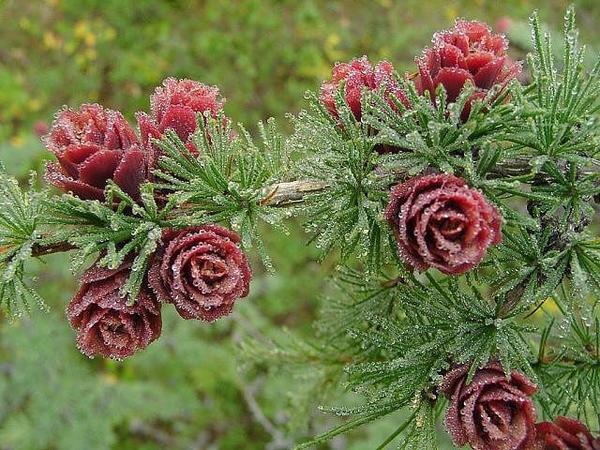
Lilka-g
Coniferous trees do not have flowers, but when spring comes, they begin to bloom with the help of cones.
Although these trees do not have flowers, they bloom just as beautifully as trees and plants that have flowers. In addition, coniferous trees have a very good smell. When you walk not far from these trees, you immediately smell the smell of spring.
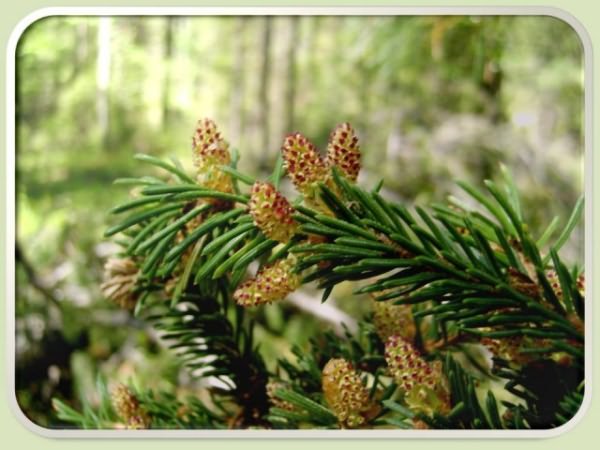
Strymbrym
Flowering of coniferous trees begins early, before the flowering of deciduous trees. The fact is that pollen from coniferous plants is carried exclusively by the wind and in order for this process to be successful, open space is required. Anther spikelets are formed, which then open and the pollen is dispersed.
12NiNeL14
Coniferous trees mainly bloom in the spring, and cedar in Siberia and Lebanon begins to bloom in the autumn. The flowers of coniferous trees are unusual, more like pot-bellied barrels, in the form of cones. Siberian and Lebanese cedar are different, the cones are different in color and shape. 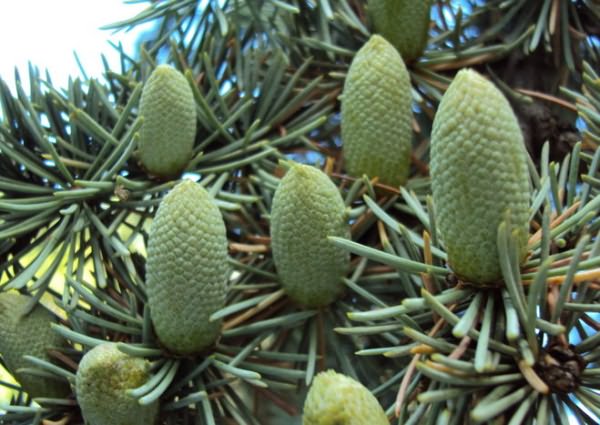
elena-kh
I'll show you in pictures how different flowers bloom. conifers. It's very beautiful.
This is how a pine tree blooms:
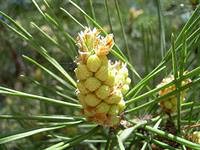
stalonevich
Do coniferous trees bloom? Of course they bloom! But only their flowers are different from those we are used to, although this makes them even more beautiful and unique. See a small selection of photographs of coniferous trees blooming: 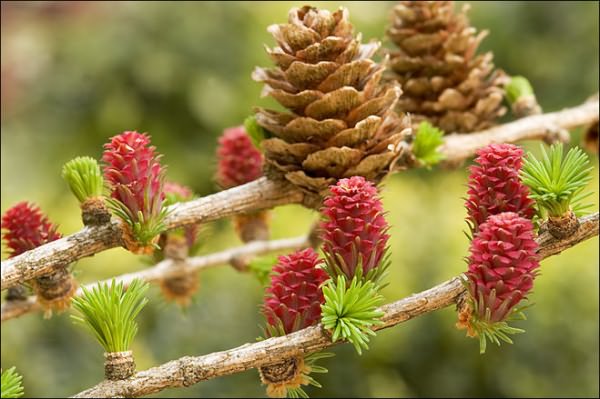
zagadka2030
Not every person has not only seen, but even knows that coniferous trees bloom with beautiful flowers.
This is how a pine tree blooms:
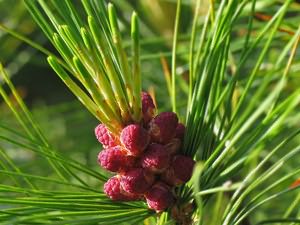
The first spring flowers are harbingers of spring and warmth. What flowers are considered primroses?
– a perennial herbaceous plant of the Ranunculaceae family. The name comes from the Greek - “spring flower”. Blooms one of first spring flowers, as soon as the first thawed patches appear. Erantis is called the harbinger of spring.
Following the Erantis, a snowdrop peeks out from under the snow.
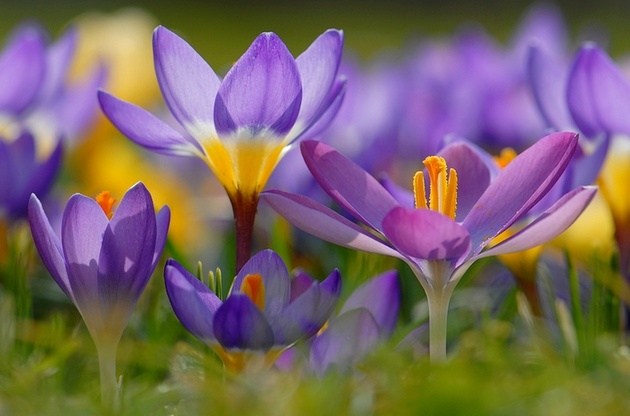 - plant of the family. iris. It got its name from the Greek “Kroke” - thread, because. dried crocus stigmas look like threads. According to legend, saffron arose from drops of the blood of the young man Krok. Krok competed with the god Hermes in discus throwing, and Hermes accidentally killed him. The first ancient saffron had yellow shades, and it received blue, pink and white colors as a result of selection. The second name, saffron, comes from the Arabic word for “yellow.” Saffron was used as a seasoning, incense, dye, and medicinal plant. It's interesting that in ancient China no one except the emperor had the right to wear saffron-colored clothing. And in some countries, women used crocus to ease childbirth.
- plant of the family. iris. It got its name from the Greek “Kroke” - thread, because. dried crocus stigmas look like threads. According to legend, saffron arose from drops of the blood of the young man Krok. Krok competed with the god Hermes in discus throwing, and Hermes accidentally killed him. The first ancient saffron had yellow shades, and it received blue, pink and white colors as a result of selection. The second name, saffron, comes from the Arabic word for “yellow.” Saffron was used as a seasoning, incense, dye, and medicinal plant. It's interesting that in ancient China no one except the emperor had the right to wear saffron-colored clothing. And in some countries, women used crocus to ease childbirth.
Adonis (Adonis)- a perennial herbaceous plant of the family. Ranunculaceae. Large adonis flowers glow golden in the sun. Adonis received its Latin name in honor of Adon, the Phoenician and Assyrian sun god, who died every year and was resurrected every spring, like this flower. There is also a version about the origin of the name from Greek mythology. Adonis disobeyed the goddess Aphrodite, who forbade him to hunt wild animals, and was mortally wounded by a boar. Aphrodite, grieving for her beloved young man, turned Adonis into a beautiful flower that is reborn every spring.
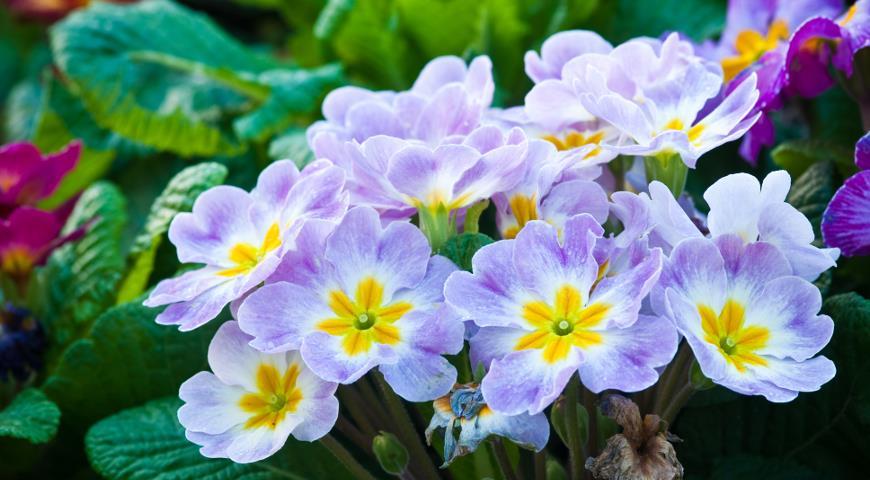 – the name of this plant comes from the word “early, first”, because primrose is one of the very first spring flowers. Primrose resembles a bunch of golden keys. In Scandinavian mythology, primrose is the key of the goddess Freya, with which she unlocks the doors of spring. According to another belief, these are the keys to heaven, which St. Peter dropped to the ground. According to Celtic belief, primrose was considered the key to marriage and was part of the love potion.
– the name of this plant comes from the word “early, first”, because primrose is one of the very first spring flowers. Primrose resembles a bunch of golden keys. In Scandinavian mythology, primrose is the key of the goddess Freya, with which she unlocks the doors of spring. According to another belief, these are the keys to heaven, which St. Peter dropped to the ground. According to Celtic belief, primrose was considered the key to marriage and was part of the love potion.
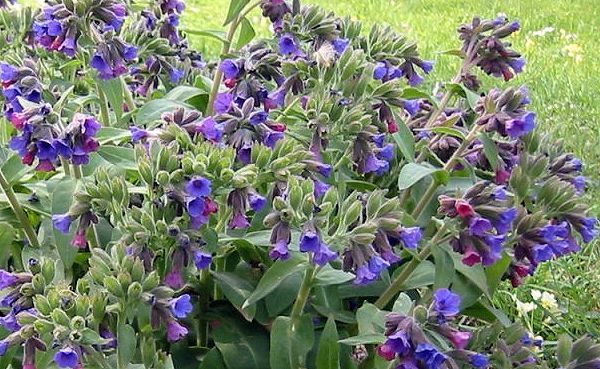 Lungwort (pulmonaria)- a small plant of the family. borage The Russian name comes from the taste and smell of the flowers - sweet, honey. Pulmonaria received its Latin name due to the use of plant leaves in the treatment of pulmonary diseases. In the lungwort inflorescence you can simultaneously see blue and red flowers, hence the legend that the blue flowers are Adam’s and the red flowers are Eve’s. In fact, young flowers are pink, and old ones are blue.
Lungwort (pulmonaria)- a small plant of the family. borage The Russian name comes from the taste and smell of the flowers - sweet, honey. Pulmonaria received its Latin name due to the use of plant leaves in the treatment of pulmonary diseases. In the lungwort inflorescence you can simultaneously see blue and red flowers, hence the legend that the blue flowers are Adam’s and the red flowers are Eve’s. In fact, young flowers are pink, and old ones are blue.
